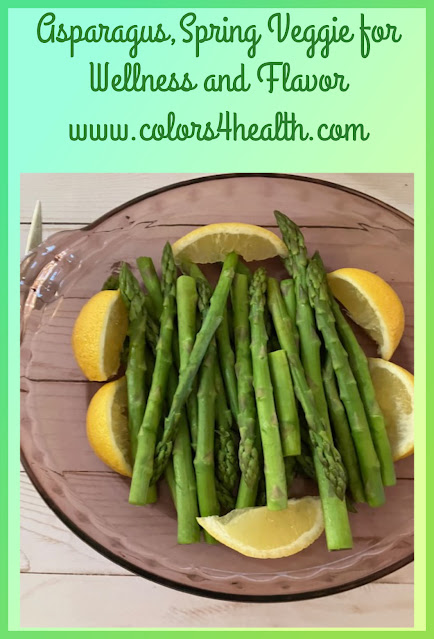Asparagus is rich in fiber and
water, making this veggie low-calorie with only 20 calories for each half-cup serving.
Eating a portion of this fiber and water rich veggie helps make us feel full
longer.
Help prevent constipation and maintain a healthy digestive tract by munching on as little as a half cup serving of asparagus.
Studies suggest that a diet high in fiber-rich fruits and vegetables may help reduce the risk of high blood pressure, heart disease, and diabetes.
Asparagus acts as a prebiotic, feeding good gut bacteria to aid digestion.
How to Select and Store
Asparagus
If you’ve ever planted asparagus in
your garden, chances are it’s going to pop up this spring. That’s part of the
beauty of this hardy, flavorful, and nutritious perennial vegetable!
Although asparagus is offered for sale in most places year round, it's most tender and flavor-packed in the springtime.
Select fresh, odorless asparagus stalks with dry, tight tips. Avoid limp or wilted stalks.
Fresh asparagus tastes best when purchased in-season and served that same day.
If that's not the case, store this veggie as you would store fresh cut flowers.
Trim the bottoms and stand the spears up in a glass or
jar in an inch of water. Cover with a plastic bag and refrigerate.
Change the water when it gets cloudy, and eat within 4-5 days.
Asparagus is harvested in North America from
February through June, reaching its peak around April.
If you live in the southern hemisphere it is reverse. For example, in Australia, the best season for
asparagus is from August to December.
How to Prepare Asparagus
Choose the right size (thickness) asparagus for each dish.
While the larger stalks are good for grilling, roasting, and barbeques the smaller, skinnier stalks are great for pasta dishes, breakfast scramble, snacking, risotto, salads, and the like.
Asparagus spears can be eaten raw. If you want to snack on them, select the thinnest stalks you can find.
Asparagus grows in sandy
soil, and needs to be cleaned thoroughly. Do this right before using.
Soak asparagus in a bowl that's filled with clean fresh water, being
especially mindful to cover the tips, where sand can accumulate.
Soak it long enough to allow sand to sink to the bottom of the bowl.
If the asparagus you select is thick, snap off the woody base by bending each spear
a few times to find a place where it breaks easily.
This is near the
bottom third of the stalk, where the tender part starts to turn woody. Or
simply line up the stem ends and trim off an inch or so.
If desired, scrape the scales off each spear using a vegetable peeler. This gives the veggie a smooth, clean look and improves the texture of tough or fat spears.
Cut
asparagus into bite size 1-inch pieces for easy handling, cooking, and eating.
Save cuttings in an airtight container in freezer. When you make veg soup or are slow cooking dishes like casseroles or stews, cook the asparagus trimmings with other ingredients.
Like all vegetables, overcooking asparagus may cause nutrients to leach out.
To steam, sauté, or boil asparagus keep the cooking time to 3-5 minutes. Be aware that cooking times vary according to the size of the asparagus stalks and number of portions you are preparing.
Recipe for Delicious Steamed Asparagus
This is the quickest, easiest recipe for mouthwatering steamed asparagus I know.
Ingredients:
1 lb. fresh spring asparagus
1-2 cups of water to steam asparagus
2 Tablespoons extra-virgin olive oil
salt and pepper to taste
juice and zest of a fresh lemon
What to do:
1. Wash asparagus as suggested above.
2. For best results, cook in a steamer, one that has a steamer basket insert.
3. Bring water to a boil before using tongs to place asparagus into the steamer basket. Then cover pot.
NOTE: a steamer basket is a handy kitchen utensil. It lifts asparagus out of the water and off the bottom of the pan. Steamer baskets prevent veggies from becoming soggy and mushy. If you don't have a steamer, use a covered sauce pan. Simply put cut asparagus directly into an inch of boiling water and cover. Just test the asparagus every minute and remove from water, as soon as asparagus stalks are fork tender.
4. Cook on medium for no more then 3-5 minutes or until asparagus are fork tender and remain bright green. Use tongs to transfer into a serving dish.
5. For heightened flavor, drizzle on a few drops of extra virgin olive oil, and season with salt, pepper, fresh squeezed lemon juice, and lemon zest. If you want a fat free version, omit the oil.
Garnish with lemon wedges, parsley, or other fresh herb of your choosing.
This recipe serves 4 as a side dish.
Additional serving suggestions:
Include steamed asparagus in rice, quinoa, or pasta dishes.
Steamed asparagus is delicious when it's a featured ingredient in a brunch or dinner spring hummus asparagus kale salad.
Prefer sweet or savory tasting asparagus? It's as simple as being intentional with the herbs and spices you use to season them.
Asparagus is awesome when added to salads, sandwiches, soups, and used as a dipper for hummus or other spreads.
No matter how you serve it, asparagus is one spring veggie too nutritious and scrumptious to pass up.
Please take this opportunity to comment below.
Do you enjoy serving asparagus at home or enjoy it only when served in a restaurant?
Did you know asparagus is so healthy and can be prepared in so many different ways?
I read and appreciate every comment, but will not be able to publish those with links. Thanks for understanding.
Please share the love by visiting my blog again. Re-share this post on social media with a link back to this post. 💓
This post has been shared at What’s for Dinner? Sunday Link up #464
This post has been shared at Whats-for-dinner-Sunday-link-up-420














